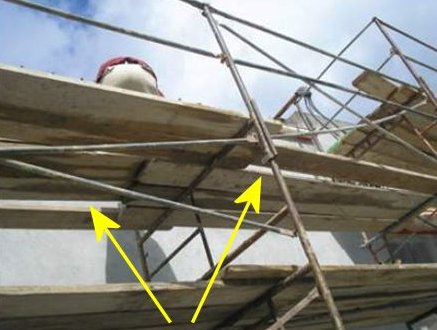Ropes
OSHA regulations for rope inspection and use in scaffolding ensure the safety and reliability of the scaffold structures. OSHA 1926.451 covers the various aspects of rope use, including hoisting, inspection, joining, repair, suspension, thimbles, tiebacks, spliced eyes, and swaging.
- Drum Hoist: When a drum hoist is used to raise or lower scaffolds, the hoist must maintain constant tension on the scaffold lines.
- Inspection: All ropes must be inspected by a competent person prior to each work shift and after any occurrence that could affect a rope’s integrity, such as adverse weather conditions. Any signs of damage or wear should be noted, and the rope should be removed from service if it's deemed unsafe.
- Joined: When ropes are joined together, the connections must be made with shackles or equivalent means that are at least as strong as the ropes and do not reduce the ropes' overall strength.
- Repaired: Any repairs to ropes must be performed in a manner that restores the ropes to their original integrity and strength. Damaged ropes must not be used until properly repaired.
- Suspension: Suspended scaffolds must be supported by ropes that are strong enough to support the scaffold load. Ropes must be capable of supporting six times the maximum intended load.
- Thimbles: When U-bolt wire rope clips are used, a thimble must be used to form eyes at wire rope connections to prevent damage to the rope and maintain its strength.
- Tiebacks: Tiebacks must be installed when counterweights are used for scaffold stability. The tiebacks must be securely anchored to a structurally sound portion of the building or structure.
- Spliced Eye: Spliced eyes on wire suspension ropes must be made using at least four tucks with a properly sized thimble to ensure the splice is secure and the rope's strength is maintained.
- Swag: Swaged fittings used in suspension rope systems must be installed in accordance with the manufacturer's recommendations to ensure proper strength and reliability.
Knots
The knots used for at connection points should be inspected to ensure they are correctly tied and secure. Incorrectly tied knots can compromise the rope's strength and lead to accidents.
- Clove Hitch: This knot is used to attach a rope to a cylindrical object like a scaffold pole. It's secure and easy to adjust.
- Lark's Head: Also known as a Cow Hitch, this knot is used to attach a rope to a bar or pole. It's a quick and secure knot that's easy to tie and untie.
- Prusik Knot: This knot is used to attach a loop of cord around a rope, allowing a person to climb or descend safely. It's a friction knot that grips the rope when weight is applied.
- Bowline: This knot creates a fixed loop at the end of a rope. It's secure and easy to untie, even after being subjected to a load.
- Sheet Bend: This knot is used to tie two ropes together. It's a strong and secure knot that's easy to tie and untie.
- Double Fisherman's Knot: This knot is used to tie two ends of a rope together. It's a secure and reliable knot that's often used in climbing and rescue operations.
- Square Knot: Also known as a Reef Knot, this knot is used to tie two ends of a rope together. It's a simple and secure knot that's easy to tie and untie.
Taglines
When a scaffold might be struck by a swinging load, taglines or equivalent means should be used to control the load.
Planking
Plank scaffold platforms fully as possible (beginning at the work surface face) with gaps between planks no more than 1 inch wide (to account for plank warp and wane).
The remaining space on bearer member (between the last plank and guardrail) cannot exceed 9 1/2 inches (the space required to install an additional plank).
Knowledge Check Choose the best answer for the question.
1-9. When should taglines be used when hoisting loads around scaffolds?
You forgot to answer the question!

